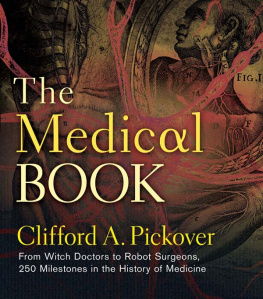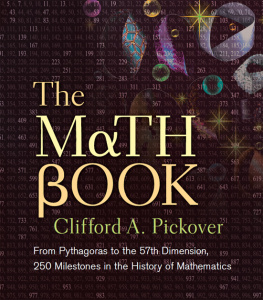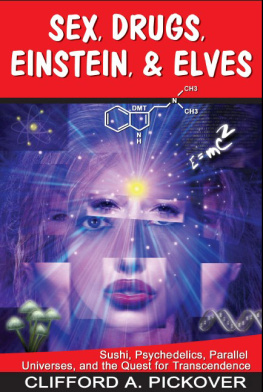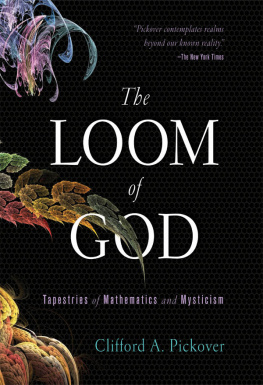Books by Clifford A. Pickover
The Alien IQ Test
Archimedes to Hawking
A Beginners Guide to Immortality
Black Holes: A Travelers Guide
Calculus and Pizza
Chaos and Fractals
Chaos in Wonderland
Computers, Pattern, Chaos, and Beauty
Computers and the Imagination
Cryptorunes: Codes and Secret Writing
Dreaming the Future
Egg Drop Soup
Fractal Horizons: The Future Use of Fractals
Frontiers of Scientific Visualization
Future Health
The Girl Who Gave Birth to Rabbits
The Heaven Virus
Jews in Hyperspace
Keys to Infinity
Liquid Earth
The Lobotomy Club
The Loom of God
The Math Book
The Mathematics of Oz
Mazes for the Mind: Computers and the
Unexpected
Mind-Bending Visual Puzzles (calendars and card sets)
The Mbius Strip
The Paradox of God and the Science of
Omniscience
A Passion for Mathematics
The Pattern Book: Fractals, Art, and Nature
The Physics Book
The Science of Aliens
Sex, Drugs, Einstein, and Elves
Spider Legs (with Piers Anthony)
Spiral Symmetry (with Istvan Hargittai)
The Stars of Heaven
Strange Brains and Genius
Sushi Never Sleeps
Surfing through Hyperspace
Time: A Travelers Guide
Visions of the Future
Visualizing Biological Information
Wonders of Numbers
The Zen of Magic Squares, Circles, and Stars
THE
MEDICAL
BOOK
FROM WITCH DOCTORS TO ROBOT SURGEONS, 250 MILESTONES IN THE HISTORY OF MEDICINE
Clifford A. Pickover
Author of The Math Book and The Physics Book


STERLING and the distinctive Sterling logo are registered trademarks of Sterling Publishing Co., Inc.
2012 by Clifford A. Pickover
All rights reserved. No part of this publication may be reproduced, stored in a retrieval system, or transmitted, in any form or by any means, electronic, mechanical, photocopying, recording, or otherwise, without prior written permission from the publisher.
ISBN 978-1-4027-8585-6 (hardcover)
ISBN 978-1-4027-9233-5 (ebook)
Library of Congress Cataloging-in-Publication Data
Pickover, Clifford A.
The medical book : from witch doctors to robot surgeons : 250 milestones in the history of medicine / Clifford A. Pickover.
p. ; cm.
From witch doctors to robot surgeons : 250 milestones in the history of medicine
ISBN 978-1-4027-8585-6 (hardcover) ISBN 978-1-4027-9233-5 (ebook)
I. Title. II. Title: From witch doctors to robot surgeons : 250 milestones in the history of medicine.
[DNLM: 1. History of MedicineChronology. WZ 30]
610.9dc23
2011050376
For information about custom editions, special sales, and premium and corporate purchases, please contact Sterling Special Sales at 800-805-5489 or specialsales@sterlingpublishing.com.
2 4 6 8 10 9 7 5 3 1
www.sterlingpublishing.com
Truly the gods have not from the beginning revealed all things to
mortals, but by long seeking, mortals make progress in discovery.
Xenophanes of Colophon, c. 500 B.C.
Wherever the art of medicine is loved, there also is love of humanity.
Hippocrates, c. 400 B.C.
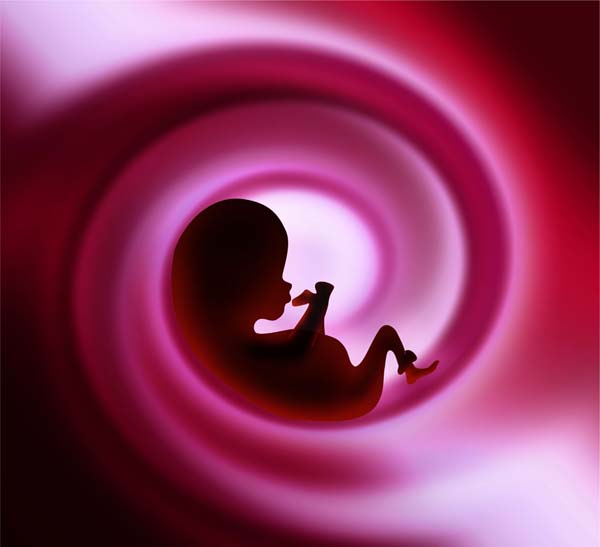
The Scope of Medicine
Welcome to The Medical Book, a vast journey into the history of medicine that includes eminently practical topics along with the odd and perplexing. Well encounter subjects that range from circumcision to near-death experiences and from witch doctors to robot surgeons. Educational content from The Great Courses provides a wonderful glimpse of the richness of medical history and the amazing progress humankind has made from the Stone Age until today:
In todays era of modern Western medicine, organ transplants are routine, and daily headlines about the mysteries of DNA and the human genome promise that the secrets of life itself are tantalizingly within our reach. Yet to reach this point took thousands of years. One step at a time humanitys medical knowledge has moved forward from a time when even the slightest cut held the threat of infection and death, when the flow of blood within the body was a mystery, and cells were not even a concept, and when the appearance of a simple instrument allowing a physician to listen to the beat of a diseased heart was a profound advance.
Each entry in The Medical Book is shortat most only a few paragraphs. This format allows readers to jump in and ponder a subject without having to sort through a lot of verbiage. When was the first time physicians studied maggot therapy to clean wounds and save lives? Turn to the entry Maggot Therapy for a brief introduction. Do acupuncture and truth serum really work? When was the first eye surgery performed? Will humans ever be able to be frozen and resurrected a century later? Whats the difference between yellow fever and sleeping sickness? Well tackle these and other thought-provoking topics in the pages that follow. Health care is among the most significant issues of our time, and it will be more so in the future. This book should appeal to students and their parents, health-care practitioners, and even many of the exuberant fans of Greys Anatomy, House M.D., and the countless medical showspast, present, and futurethat capture our hearts and minds.
When colleagues ask me what I feel are the greatest milestones in medicine, I usually offer three events. The first involves the use of ligatures to stem the flow of blood during surgeries, for example, as performed by the French surgeon Ambroise Par (15101590). He promoted the ligature (e.g., tying off with twine) of blood vessels to prevent hemorrhage during amputations, instead of the traditional method of burning the stump with a hot iron to stop bleeding. The second key milestone includes methods for decreasing pain through general anesthetics such as ether, attributed to several American physicians. The third breakthrough concerns antiseptic surgery, which was promoted by British surgeon Joseph Lister (18271912), whose use of carbolic acid (now called phenol) as a means of sterilizing wounds and surgical instruments dramatically reduced postoperative infections.
If pressed, I would add two additional key developments in the history of medicine. The use of X-rays was the first of several groundbreaking modern approaches for visualizing the interior of living humans. Also very important was the gradually increasing openness of physicians and authorities to the dissection of bodies in order to learn about human anatomy. In fact, several milestones in this book offer portrayals of the human body by such greats as Leonardo da Vinci (14521519), Bartolomeo Eustachi (15001574), Andreas Vesalius (15141564), Pietro da Cortona (15961669), William Cheselden (16881752), Bernhard Siegfried Albinus (16971770), William Hunter (17181783), and Henry Gray (18271861). In order to become seasoned dissectors and anatomists, surgeons of the past often were able to suppress normal emotional responses for their human brethren. For example, English physician William Harvey (15781657), famous for his elucidation of blood circulation, participated in dissections of both his sister and his father. In the early 1800s, the appetite for corpses was so great in England that anatomists frequently collaborated with grave robbers to secure needed specimens. As I mention later in this book, art historians Martin Kemp and Marina Wallace write, The portrayal of the human body, however ostensibly neutral or technical the illustration, always involves a series of choices, and invariably brings into play strong sensations. Historical images of the dissected body range from the most flamboyant of the multicolored waxes, in which dissected figures assume the roles of expressive actors and actresses in their own timeless drama, to the remorselessly sober woodcuts in Henry Grays famous
Next page
